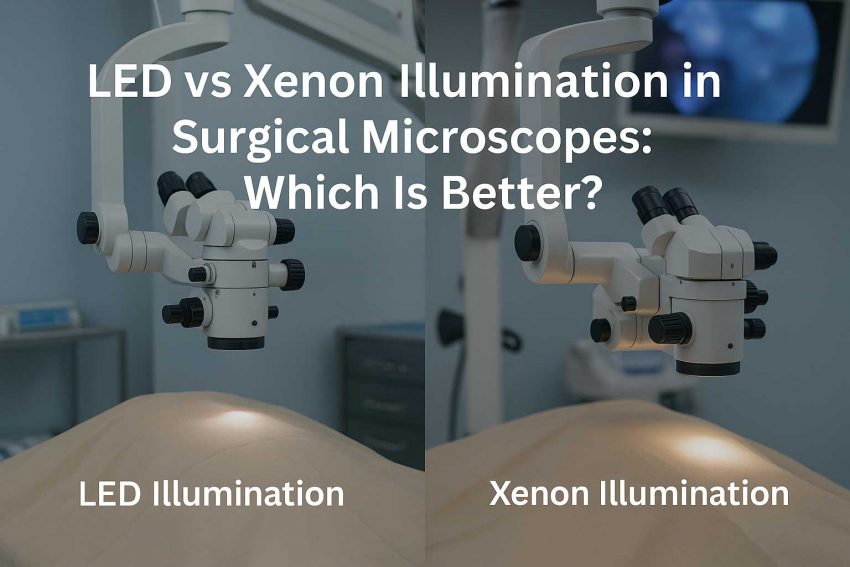Choosing the right illumination system for your surgical microscope can directly affect visibility, tissue safety, and overall performance. In today’s market, two light sources dominate: LED (Light-Emitting Diode) and Xenon gas discharge lamps.
But which is better for your surgical needs—LED or Xenon? In this article, we compare both technologies across brightness, color accuracy, cost, lifespan, and heat output to help you make an informed choice.
What Is Xenon Illumination?
Xenon lamps produce a bright white light using high-voltage electrical discharge through ionized xenon gas. They’ve been the gold standard in surgical microscopes for years, especially in ophthalmology and neurosurgery.
Pros:
- High intensity light (up to 180W or more)
- Excellent color rendering (CRI >90)
- Effective in deep surgical cavities
Cons:
- Generates a lot of heat (requires cooling fans)
- Bulbs degrade quickly—often need replacement every 500–1000 hours
- More expensive to maintain
Best for: High-depth surgery, critical color precision, deep-body illumination
What Is LED Illumination?
LED (Light Emitting Diode) technology has surged in popularity due to its cooler, longer-lasting, and energy-efficient operation. Newer models match or surpass Xenon in intensity and stability.
Pros:
- Long lifespan (20,000–50,000+ hours)
- Cool light with little heat output
- More energy efficient and cost-effective
- Compact design allows for smaller microscope builds
Cons:
- May have slightly lower color rendering in older models
- Less ideal in extremely deep surgical fields (older models)
Best for: General surgery, outpatient settings, dental, ENT, long procedures
Side-by-Side Comparison Table
| Feature | Xenon | LED |
|---|---|---|
| Brightness | Very High (up to 300,000 lux) | High (up to 240,000+ lux in newer models) |
| Color Rendering (CRI) | Excellent (>90) | Good to Excellent (85–95) |
| Heat Generation | High – requires cooling fans | Low – cool operation |
| Maintenance | Frequent bulb replacement | Minimal – lasts 20,000+ hours |
| Energy Efficiency | Low | High |
| Cost | Higher (bulbs + cooling) | Lower (fewer replacements) |
| Suitability for Long Procedures | Moderate (heat may affect comfort) | Excellent |
Specialty Recommendations
Depending on your field, one illumination system may be more suitable than the other:
- Neurosurgery: Xenon for deep brain procedures; LED for outpatient spine work
- Ophthalmology: Xenon for retina, LED for anterior segment or cataracts
- Dental: LED (lightweight, no heat, excellent clarity)
- ENT: LED for comfort during long outpatient surgeries
- Plastic Surgery: Either, depending on preference; LED preferred for ergonomic reasons
Final Verdict: LED or Xenon?
Both LED and Xenon have clear benefits, but LED illumination has rapidly become the preferred choice in 2025 thanks to its:
- Cool, safe lighting for long procedures
- Lower long-term cost
- Sustainability and energy efficiency
However, Xenon still holds its ground in high-intensity, deep-cavity procedures where color fidelity is non-negotiable. If you require maximum brightness and deep tissue exposure, Xenon remains a strong option—especially in advanced neurosurgical and ophthalmic work.
For most modern clinics, though, LED surgical microscopes strike the perfect balance of performance, cost, and convenience.
